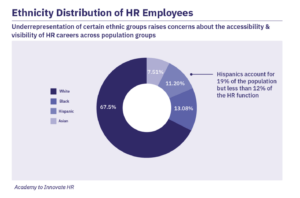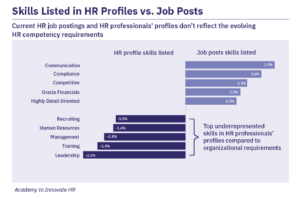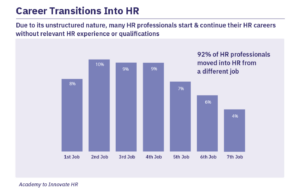Introduction
The imperative for HR to adapt to the future is hardly a novel idea. Yet recent developments in generative AI, tightening labor markets, and evolving employee relations have underscored the urgency of repositioning HR for forthcoming challenges.
There is broad recognition of the crucial role HR will play in shaping the future of work. The lingering question is: what will the future of HR look like, and how can we ensure the profession is equipped to meet new expectations?
Our comprehensive “State of HR” study was designed to address these questions. We analyzed three million HR profiles, gathered data from over 1,000 HR professionals, and conducted detailed interviews with ten senior HR leaders to pinpoint what preparations are necessary for HR to navigate the future work landscape effectively.
This article identifies five key priorities that should be at the forefront of today’s HR agenda.
Priority 1: Invest in HR Capacity aligned to other business functions.
The HR function has experienced significant growth over the last five years and is projected to increase by 10 percent by 2030. However, despite this growth, HR represents only two percent of all U.S. employees, a lower share than other functions such as Marketing, Operations, and Administration. This disparity underscores the need for HR to address the imbalance and adapt to the changing landscape.

Despite 80 percent of the workforce being deskless and frontline workers outside of head office environments, HR functions are primarily found in larger metropolitan areas.
 This work environment produces less representation in factories, branches, and distribution hubs. The stretched HR capacity creates challenges for HR professionals, their employee experience, and the strength of talent pipelines. It also means that HR is seen as a head office function primarily responsible for hiring and firing.
This work environment produces less representation in factories, branches, and distribution hubs. The stretched HR capacity creates challenges for HR professionals, their employee experience, and the strength of talent pipelines. It also means that HR is seen as a head office function primarily responsible for hiring and firing.
For HR to meaningfully contribute to the future of work, three actions need to be on the agenda:
1. Align HR operating models to the business
To enhance HR service delivery and support business growth and performance, it’s essential to redesign HR operating models and align them with organizational development and complexity rather than just workforce size. By doing so, HR resources can be invested more effectively, resulting in a more significant impact on the organization.
2. Invest in technology.
HR must embrace technology, including automation and AI, in HR processes. Enhanced technology will allow HR professionals to streamline transactional tasks and focus on delivering results at scale.
3. Rethink HR team distribution.
Another way to improve HR effectiveness is to distribute HR teams according to the organization’s geographic footprint. Distributed HR can change the perception of HR as solely a headquarters function while also increasing visibility and fostering closer collaboration with employees and business units.
Priority 2: Practice what we preach in terms of HR workforce diversity.
Recognizing the current diversity gaps within the HR function and their implications is essential. In the US, women comprise 68.2% of the HR function, significantly higher than the broader workforce. This trend is consistent globally, highlighting the dominance of women in HR. The overrepresentation of women in the HR profession is likely due to its historical association with stereotypically feminine and “soft skills” focus, which is typically associated with women.
Although more diverse than other functions, HR diversity is not representative of the overall population diversity, given that the HR function is predominantly white (67.5%) in the US. Hispanics are proportionately underrepresented in HR roles, in contrast to their 19% presence in the US population.

The underrepresentation of certain ethnic groups raises concerns about the accessibility and visibility of HR careers across all populations.
Around 60 percent of HR professionals fall in the 20-40 age range, indicating a relatively young workforce in the HR function. Most HR professionals (57 percent) also hold junior or entry-level positions. Senior roles still lack representation of minority groups, which could limit diversity based on the small number of positions at this level. This lack of diversification affects HR professionals’ availability and institutional knowledge development.
To address the diversity dilemma in HR, HR must focus on the following actions:
1. Assess talent pipelines.
It’s vital to assess talent pipelines and the sources from which you are attracting talent. As you do for your business, you need a diverse sourcing and development strategy to ensure you have a talented HR team for the future.
2. Break role stereotypes.
HR needs strong leaders and associations to break role stereotypes and advocate for the profession. This will help showcase the diverse skills and profiles required for a successful HR team.
Priority 3: Create clarity on HR skill requirements.
HR professionals face constantly evolving skill requirements driven by the increasingly complex operating environment. These requirements include business acumen, change management, data literacy, and technology integration. However, our research shows that organizations’ job postings must reflect these changes. HR job postings still overemphasize generic skills such as administrative tasks, effective communication, and compliance.

This mismatch in skill requirements indicates a potential problem of ill-defined HR roles that must accurately articulate job requirements. The ambiguity in skill requirements could inhibit future exploration and adoption of new HR operating models. Moreover, the lack of clarity in skill requirements undermines HR professionals’ skill development efforts, impacting the reputation and perception of HR within organizations. This mismatch also hinders the ability to demonstrate the business impact.
To address the mismatch between skills and requirements, these actions should be prioritized:
1. Create clarity on HR skill requirements beyond generic, outdated descriptions.
Translate modern competency models into practical job descriptions that align with how businesses perceive the value of various HR roles.
2. Redesign HR roles.
Redefine HR roles and responsibilities in line with modern business needs. Integrate modern skills like digital and data as core components of the HR professional profile. This requires work design, internal change, and communication efforts to shift expectations and ensure that businesses know what is expected of HR professionals.
Priority 4: Redefine the HR career to build a robust HR talent pool with the right skills.
Our research shows that HR careers are often unplanned and unstructured. About 72% of HR professionals begin their careers before age 30, with only 18 percent starting in HR as their first or second role.

Most HR professionals have prior experience in humanities, social sciences, or administration before entering HR. They start their careers in HR because they are motivated by their interest in people and desire to create a business impact.
This unplanned or unstructured approach to HR careers is also evident in how HR careers unfold. As many as 17% of individuals reported that their careers in HR need to follow a distinct path or trajectory. Instead, personal interests, motivation, and opportunities largely shape their career path. Most HR career paths are still traditional and linear, meaning professionals steadily climb the ranks within a specific HR domain (32% of respondents). However, some HR professionals (23%) opt for upward and lateral progression between different HR areas of expertise. Around 17% of respondents also indicated that they had gained in-depth knowledge and responsibility within a particular skill set by moving within the broader HR function. Fewer HR professionals (11%) explore careers that involve transitions between HR and other business functions.
This unstructured nature of HR careers impacts the development and availability of future-ready HR skills, as well as the career opportunities available to HR professionals:
1. Upskill, reskill, and cross-skill.
This approach allows HR professionals to develop skills through practical exposure and is crucial for robust HR development.
2. Structure and formalize HR professionals’ career development.
To structure and formalize HR professionals’ career development, consider creating HR Academies focusing on future HR skills. Align these academies to the requirements of strategic HR operating models and new competency profiles. At AIHR, HR professionals require T-shaped competencies, and HR Academies can be structured to build these skills.
3. Make HR careers attractive.
To make HR careers attractive, we need to create more structure for early HR careers while making non-traditional career paths visible and actionable within organizations. This will drive HR as a career choice rather than an accidental occurrence, making it a sustainable profession.
Priority 5: Proactively address the emerging Chief People Officer crisis.
Our data showcased an exodus of HR talent at the mid-career stage, citing organizational politics, leadership changes, and a desire to break free from organizational bureaucracy as critical reasons for exploring alternate career opportunities outside traditional HR teams. Similar studies have highlighted that only 40 percent of senior HR individuals aspire to move into the CPO role in the future. At the same time, current CPO turnover levels are higher than those of other C-suite members.
This is concerning as it implies an emerging CPO crisis on the horizon. As HR aims to navigate the complexity of the future of work, strong leadership will be required to weather the storm. Yet, it seems we are not building a readily available senior HR leadership talent pool with the desire to do the job. Similarly, the skills of the future HR leader will be different, especially given the increasingly complex stakeholder environment and responsibilities such as environmental, social, and governance (ESG) becoming crucial to the success of HR.
Preparing a willing and able future CPO talent pool will require action in terms of the following:
1. Redefine the CPO Employee Value Proposition.
Attention needs to be paid to the CPO EVP to make the role more attractive and meaningful for future talent. The EVP must go beyond financial means, yet this is a good starting point for closing the pay gap between CPOs and the rest of the C-suite.
2. Legitimize the CPO role in terms of its influence on the organization.
To ensure the sustainability of the CPO role, we require legitimizing the role as part of the C-suite and the inner circle of business decision-making. This positioning will only occur if organizations let go of past-held beliefs about the HR profession and promote HR values differently in the future.
3. Develop CPO talent that is confident and self-aware.
To effectively prepare for their roles, CHROS must clearly understand their belief system and its influence on their professional identity. This clarity aids them in making difficult decisions, navigating through ambiguity, and staying true to their purpose. Self-awareness is critical in leadership, but for CHROs, the ability to reflect on and understand their strengths and limitations is particularly vital.
Final Words
The future of HR has the potential to significantly impact organizations and individuals. However, to reach this potential, the HR profession must first acknowledge and address some of its systemic barriers and challenges.
We firmly believe that the future holds significant opportunities for HR, but we need to be pragmatic about the function’s current reality and what needs to change.
HR could shape a future where work is purposeful, organizations thrive, and society flourishes, but the question remains whether we dare to transform ourselves first.





